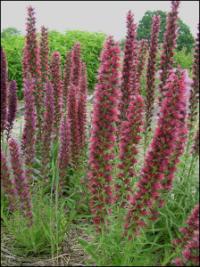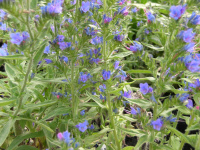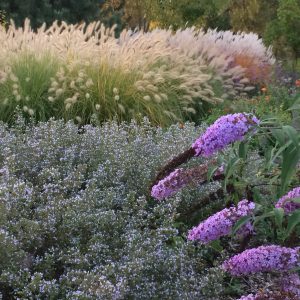Archives
Showing 65–72 of 164 results
-
Echinacea purpurea Purple coneflower Z 3-8
Iconic dark pink rays with orange-rust cones from mid-summer to fall
ARCHIVED
Note: This is a plant not currently for sale. This is an archive page preserved for informational use.
Iconic dark pink rays with orange-rust cones from mid-summer to fall
Size: 3’ x 18”
Care: sun in well-drained humusy soil
Native: MI S. to Louisiana, incl. Wisconsin
Wildlife Value: Attracts many butterfly species in the summer. In winter Gold finches feast on the seeds.American Indians used Purple coneflower as a remedy for more ailments than any other plant, e.g. smoke treatment to cure headaches and sexually transmitted diseases, applied topically to toothaches and mumps and juice used for burns. The Winnebagos used the plant in advance to protect against burns. Also used to cure distemper in horses. Introduced into garden cultivation by John Tradescant the Younger in 1640.
-
Echium russicum Vipers bugloss Z 2-9
Striking spikes of wine red from May to July
ARCHIVED
Note: This is a plant not currently for sale. This is an archive page preserved for informational use.
Striking spikes of watermelon, wine red from May to July – exceptional and rare.
Size: 20" x 16"
Care: Sun in moist well-drained soil. Deer resistant
Native: Russia & eastern EuropeBristly hairs on stems can cause skin irritation. Collected by Johann Gmelin, German botanist, before 1791 who spent 10 years in Russia searching for plants, nearly dying in the process.
-
Echium vulgare Vipers bugloss Self-sowing biennial Z 3-8
Spikes of true blue blossoms touched with a hint of pink, May through September
ARCHIVED
Note: This is a plant not currently for sale. This is an archive page preserved for informational use.
Spikes of true blue blossoms touched with a hint of pink, May through September. Self-seeds readily, considered noxious weed in Washington. Bristly hairs on stems can cause skin irritation
Can not ship to: Idaho, Maryland and Montana
Size: 2-3’ x 12”
Care: sun in most any soil
Native: Europe.
Wildlife Value: Important pollinator for bees.In past leaves boiled for a tea to remedy headaches and fevers. In mid-1700’s grew on chalky lands over most of England. Echium is Greek for Viper’s bugloss because a concoction of the root and wine supposedly cured snake bites or acc’d to Gardeners’ Dictionary 1768 “because the ripe seed of this plant resembles the head of a viper.”
-
Edraianthus pumelo Dwarf grassybells Z 5-8
June to July cushion of up-facing purple bells atop silvery leaves
ARCHIVED
Note: This is a plant not currently for sale. This is an archive page preserved for informational use.
June to July cushion of up-facing purple bells atop silvery leaves
Size: 1” x 3”
Care: sun in very well-drained soil
Native: Balkins
Awards: Royal Horticultural Society Award of MeritDescribed in 1819 and named as a Campanula. Name changed in 1839.
-
Emily Dickinson Garden for sun
Emily Dickinson Garden for sun.
ARCHIVED
Note: This collection is not currently for sale. This is an archive page preserved for informational use.
Emily Dickinson Garden for Sun Size : Height x width* Bloom color
1 Alcea rosea – Hollyhock 2-3’ x 2’ varies
3 Aquilegia canadensis – Canada columbine 24-36”x 12” red
1 Aster novae angliae – New England aster 3-4’ x 24” pink or purple
3 Campanula rotundifolia – Harebell 9-12” x 8” blue
1 Clematis virginiana – Virgin’s bower (vine) 12-20’ x 4’ white
3 Geranium pratense – Meadow Cranesbill 24-36” x 24” bluish-violet
1 Iris siberica – Siberian iris 3-4’ x 12” purple
3 Lilium lancifoliuim – Tiger lily 3-4’ x 12” orange
1 Peony ‘Sarah Bernhardt’ 36” x 36” pink
3 Zizia aurea – Golden alexander 30″ x 24″ yellowAll plants are perennials except the Hollyhock which is a reseeding biennial.
If planted together in one garden these make a 30 square foot garden. **Most of these plants get wider over time by spreading roots or by self-seeding . -
Engelmannia peristenia syn. E. pinnatafida Engelmann’s Daisy Z 4-8
Clusters of golden-yellow daisy-like flowers, May-August, over an evergreen rosette
ARCHIVED
Note: This is a plant not currently for sale. This is an archive page preserved for informational use.
Clusters of golden-yellow daisy-like flowers, May-August, over an evergreen rosette
Size: 18-36” x 15-18”
Care: full sun in well-drained soil. Drought tolerant.
Native: South central US
Wildlife Value: Attracts birds for the seeds, Bees & butterflies for nectar/pollen. Rabbit resistant.First published in 1840 by Nuttal/Gray. Named for George Engelmann (1809-1884) who was born in Germany and settled in St. Louis, Missouri, as a young man. He was a physician and botanist. When he died much of his collection went to Missouri Botanical Garden.
-
Eryngium amethystinum Amethyst sea holly Z. 3-8
Metallic amethyst stems, spiny bracts and cone-shaped flower in July and August
ARCHIVED
Note: This is a plant not currently for sale. This is an archive page preserved for informational use.
Metallic amethyst stems, spiny bracts and cone-shaped flower in July and August
Size: 28” x 28”
Care: Full sun in well-drained soil, drought tolerant
Native: Italy & southern Alps
Wildlife Value: attracts bees & butterflies, birds eat seeds. Deer & rabbit resistant
Awards: Great Plant Pick Award from Elizabeth Carey Miller Botanical Garden.Garden cultivation since 1648. Long prized for its metallic luster.
-
Fall Garden for sun
Fall Blooming Garden for sun.
ARCHIVED
Note: This collection is not currently for sale. This is an archive page preserved for informational use.
Fall garden for Sun Size : Height x width* Bloom color
3 Aster cordifolius – Blue wood aster 2-3’ x 2-3’ blue
1 Boltonia asteroides – Bolton’s aster 5-6’ x 3’ white
1 Chrysanthemum ‘Clara Curtis’ 2’ x 2’ pink
1 Imperata cylindrical – Japanese bloodgrass 16-20” x 12” red leaves
1 Miscanthus purpurascens – Flame grass 4-5’ x 3-4’ orange-red leaves
1 Nipponanthemum nipponicum – Nippon daisy 2-3’ x 2-3’ white
1 Pennisetum orientale – Oriental fountaingrass 2′ x 2′ pink
1 Persicaria affinis – Dwarf fleeceflower 8-12” x 3’ red
3 Sedum sieboldii – October daphne 4” x 8” pink
3 Sedum spurium ‘Coccineum’ – Dragon’s blood 6” x 24” redAll plants are perennials.
If planted together in one garden these make a 36 square foot garden. **Most of these plants get wider over time by spreading roots or by self-seeding .
16 plants for $148.92. Would be $175.20 if purchased separately. You save $26.28.
If you plan on coming to the Nursery to purchase this collection, please give us at least 24 hours notice to prepare the collection for you





